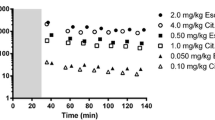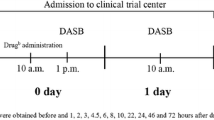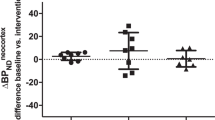Abstract
Objectives
Previous studies have investigated the occupancy of the serotonin reuptake transporter (SERT) after clinical doses of citalopram and other selective serotonin reuptake inhibitors. In the present study, the occupancies of SERT after multiple doses of escitalopram and citalopram were compared using the radioligand [123I]ADAM and single photon emission computed tomography (SPECT).
Methods
Fifteen healthy subjects received escitalopram 10 mg/day (n = 6) or citalopram 20 mg/day (n = 9) for a total of 10 days. SERT occupancies in midbrain were determined with SPECT and [123I]ADAM at three different time points: at baseline (no medication) and at 6 and 54 h after last drug intake.
Results
At 6 h after the last dose, mean SERT occupancies were 81.5 ± 5.4% (mean±SD) for escitalopram and 64.0 ± 12.7% for citalopram (p < 0.01). At 54 h after the last dose, mean SERT occupancies were 63.3 ± 12.1% for escitalopram and 49.0 ± 11.7% for citalopram (p < 0.05). The plasma concentrations of the S-enantiomer were of the same magnitude in both substances. For both drugs, the elimination rate of the S-enantiomer in plasma was markedly higher than the occupancy decline rate in the midbrain.
Conclusion
The significantly higher occupancy of SERT after multiple doses of escitalopram compared to citalopram indicates an increased inhibition of SERT by escitalopram. The results can also be explained by an attenuating effect of R-citalopram on the occupancy of S-citalopram at the SERT.



Similar content being viewed by others
References
Backstrom I, Bergstrom M, Marcusson J (1989) High affinity [3H]paroxetine binding to serotonin uptake sites in human brain tissue. Brain Res 486:261–268
Bauer M, Whybrow PC, Angst J, Versiani M, Möller HJ, WFSBP Task Force on Treatment Guidelines for Unipolar Depressive Disorders (Allain H, Anderson I, Ayuso-Gutierrez JL, Baldwin D, Bech P, Benkert O, Berk M, Bitter I, Bourgeois ML, Burrows G, Cassano G, Cetkovich-Bakmas M, Cookson JC, da Costa D, Gheorghe MD, Heinze G, Higuchi T, Hirschfeld RM, Höschl C, Hoelsboer-Trachsler E, Kasper S, Katona C, Keller MB, Kulhara P, Kupfer DJ, Lecrubier Y, Leonard B, Licht RW, Lingjaerde O, Lublin H, Mendlewicz J, Mitchell P, Paykel ES, Puzynski S, Rush AJ, Rybakowski JK, Schweitzer I, Unützer J, Vestergaard P, Vieta E, Yamada K) (2002) World Federation of Societies of Biological Psychiatry (WFSBP) guidelines for biological treatment of unipolar depressive disorders, part 1: acute and continuation treatment of major depressive disorder. World J Biol Psychiatry 3:5–43
Baumann P, Larsen F (1995) The pharmacokinetics of citalopram. Rev Contemp Pharmacother 6:287–295
Colonna L, Andersen HF, Reines EH (2005) A randomized, double-blind, 24-week study of escitalopram (10 mg/day) versus citalopram (20 mg/day) in primary care patients with major depressive disorder. Curr Med Res Opin 21(10):1659–1668, (Oct)
Gutierrez MM, Rosenberg J, Abramowitz W (2003) An evaluation of the potential for pharmacokinetic interaction between escitalopram and the cytochrome P450 3A4 inhibitor ritonavir. Clin Ther 25:1200–1210
Herold N, Uebelhack K, Franke L, Amthauer H, Luedemann L, Bruhn H, Felix R, Uebelhack R, Plotkin M (2006) Imaging of serotonin transporters and its blockade by citalopram in patients with major depression using a novel SPECT ligand [(123)I]-ADAM. J Neural Transm 113:659–670
Kasper S (2004) Unique mechanism of action for escitalopram: does it hold the promise? Int J Psychiatry Clin Pract 8:15–18
Kish SJ, Furukawa Y, Chang LJ, Tong J, Ginovart N, Wilson A, Houle S, Meyer JH (2005) Regional distribution of serotonin transporter protein in postmortem human brain: is the cerebellum a SERT-free brain region? Nucl Med Biol 32(2):123–128, 2005 (Feb)
Klein N, Sacher J, Geiss-Granadia T, Attarbaschi T, Mossaheb N, Lanzenberger R, Pötzi C, Holik A, Spindelegger C, Asenbaum S, Dudczak R, Tauscher J, Kasper S (2006) In vivo imaging of serotonin transporter occupancy by means of SPECT and [123I]ADAM in healthy subjects treated with different doses of escitalopram or citalopram. Psychopharmacology 3:263–272
Larsen F, Priskorn M, Overo KF (2001) Lack of citalopram effect on oral digoxin pharmacokinetics. J Clin Pharmacol 41:340–346
Lingjaerde O, Ahlfors UG, Bech P, Dencker SJ, Elgen K (1987) The UKU side effect rating scale. A new comprehensive rating scale for psychotropic drugs and a cross-sectional study of side effects in neuroleptic-treated patients. Acta Psychiatr Scand Suppl 334:1–100
Meyer JH, Wilson AA, Ginovart N, Goulding V, Hussey D, Hood K, Houle S (2001) Occupancy of serotonin transporters by paroxetine and citalopram during treatment of depression: a [(11)C]DASB PET imaging study. Am J Psychiatry 158:1843–1849
Meyer JH, Wilson AA, Sagrati S, Hussey D, Carella A, Potter WZ, Ginovart N, Spencer EP, Cheok A, Houle S (2004) Serotonin transporter occupancy of five selective serotonin reuptake inhibitors at different doses: an [11C]DASB positron emission tomography study. Am J Psychiatry 161:826–835
Moore N, Verdoux H, Fantino B (2005) Prospective, multicentre, randomized, double-blind study of the efficacy of escitalopram versus citalopram in outpatient treatment of major depressive disorder. Int Clin Psychopharmacol 20:131–137
Mork A, Kreilgaard M, Sanchez C (2003) The R-enantiomer of citalopram counteracts escitalopram-induced increase in extracellular 5-HT in the frontal cortex of freely moving rats. Neuropharmacology 45:167–173
Murdoch D, Keam SJ (2005) Escitalopram: a review of its use in the management of major depressive disorder. Drugs 65:2379–2404
Noble S, Benfield P (1997) Citalopram: a review of its pharmacology, clinical efficacy and tolerability in the treatment of depression. CNS Drugs 8:410–432
Oya S, Choi SR, Hou C, Mu M, Kung MP, Acton PD, Siciliano M, Kung HF (2000) 2-((2-((dimethylamino)methyl)phenyl)thio)-5-iodophenylamine (ADAM): an improved serotonin transporter ligand. Nucl Med Biol 27:249–254
Sacher J, Asenbaum S, Klein N, Geiss-Granadia T, Mossaheb N, Pötzi C, Attarbaschi T, Lanzenberger R, Dudczak R, Kasper S, Tauscher J (2006) [123I]ADAM: a novel SPECT ligand for quantification of serotonin transporters in humans. Int J Neuropsychopharmacology Feb. 17, 1--8 [Epub ahead of print]
Sanchez C, Boyeso KP, Ebert B, Reines EH, Braestrup C (2004) Escitalopram versus citalopram: the surprising rde of the R-enantiomer. Psychopharmacology 174(2):163--176
Sogaard B, Mengel H, Rao N, Larsen F (2005) The pharmacokinetics of escitalopram after oral and intravenous administration of single and multiple doses to healthy subjects. J Clin Pharmacol 45:1400–1406
Takano A, Suhara T, Ichimiya T, Yasuno F, Suzuki K (2006) Time course of in vivo 5-HTT transporter occupancy by fluvoxamine. J Clin Psychopharmacol 26:188–191
Tauscher J, Jones C, Remington G, Zipursky RB, Kapur S (2002a) Significant dissociation of brain and plasma kinetics with antipsychotics. Mol Psychiatry 7:317–321
Voirol P, Rubin C, Bryois C, Kosel M, Buclin T, Baumann P (1999) Pharmacokinetic consequences of a citalopram treatment discontinuation. Ther Drug Monit 21:263–266
Acknowledgement
This study was supported by an unrestricted grant from H. Lundbeck A/S and the “Bürgermeisterfonds der Stadt Wien” PNr: 2180/03.
Statement of interest
SK has received research grants, consultancy fees and lecture fees from a number of pharmaceutical companies in the area of CNS development including Lundbeck, the manufacturer of citalopram and escitalopram, and JT works now as an employee for Eli Lilly.
Author information
Authors and Affiliations
Corresponding author
Rights and permissions
About this article
Cite this article
Klein, N., Sacher, J., Geiss-Granadia, T. et al. Higher serotonin transporter occupancy after multiple dose administration of escitalopram compared to citalopram: an [123I]ADAM SPECT study. Psychopharmacology 191, 333–339 (2007). https://doi.org/10.1007/s00213-006-0666-y
Received:
Accepted:
Published:
Issue Date:
DOI: https://doi.org/10.1007/s00213-006-0666-y




